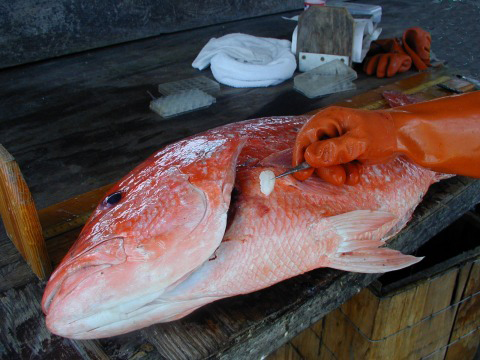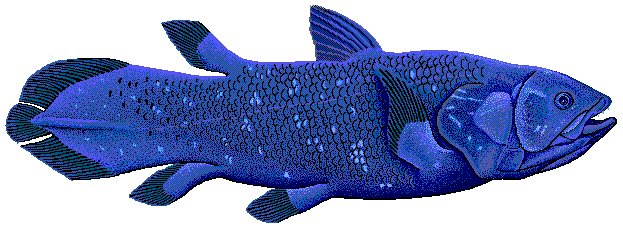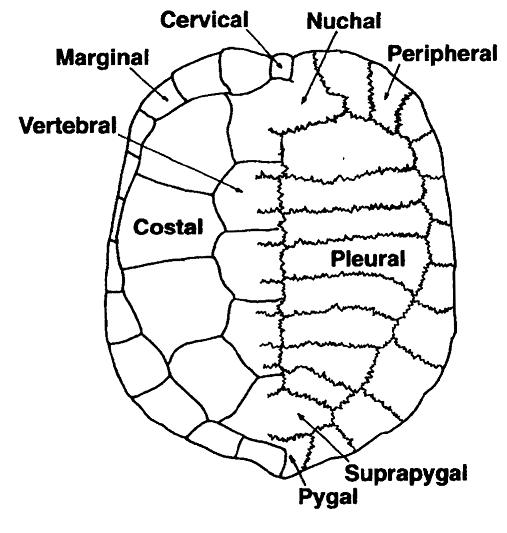|
Estimating The Age Of Fish
Knowledge of fish age characteristics is necessary for stock assessments, and to develop management or conservation plans. Size is generally associated with age; however, there are variations in size at any particular age for most fish species making it difficult to estimate one from the other with precision.Helfman et al 1997 Therefore, researchers interested in determining a fish age look for structures which increase incrementally with age. The most commonly used techniques involve counting natural growth rings on the scales, otoliths, vertebrae, fin spines, eye lenses, teeth, or bones of the jaw, pectoral girdle, and opercular series. Even reliable aging techniques may vary among species; often, several different bony structures are compared among a population in order to determine the most accurate method. History Aristotle (ca. 340 B.C.) may have been the first scientist to speculate on the use of hard parts of fishes to determine age, stating in ''Historica Animalium ... [...More Info...] [...Related Items...] OR: [Wikipedia] [Google] [Baidu] |
Yellow Perch
The yellow perch (''Perca flavescens''), commonly referred to as perch, striped perch, American perch or preacher is a freshwater perciform fish native to much of North America. The yellow perch was described in 1814 by Samuel Latham Mitchill from New York. It is closely related, and morphologically similar to the European perch (''Perca fluviatilis''); and is sometimes considered a subspecies of its European counterpart. Latitudinal variability in age, growth rates, and size have been observed among populations of yellow perch, likely resulting from differences in day length and annual water temperatures. In many populations, yellow perch often live 9 to 10 years, with adults generally ranging in length. The world record for a yellow by weight is , and was caught in May 1865 in Bordentown, New Jersey, by Dr. C. Abbot. It is the longest-standing record for a freshwater fish in North America. Description The yellow perch has an elongate, laterally compressed body with a subte ... [...More Info...] [...Related Items...] OR: [Wikipedia] [Google] [Baidu] |
Vertebrae
Each vertebra (: vertebrae) is an irregular bone with a complex structure composed of bone and some hyaline cartilage, that make up the vertebral column or spine, of vertebrates. The proportions of the vertebrae differ according to their spinal segment and the particular species. The basic configuration of a vertebra varies; the vertebral body (also ''centrum'') is of bone and bears the load of the vertebral column. The upper and lower surfaces of the vertebra body give attachment to the intervertebral discs. The posterior part of a vertebra forms a vertebral arch, in eleven parts, consisting of two pedicles (pedicle of vertebral arch), two laminae, and seven process (anatomy), processes. The laminae give attachment to the ligamenta flava (ligaments of the spine). There are vertebral notches formed from the shape of the pedicles, which form the intervertebral foramina when the vertebrae articulation (anatomy), articulate. These foramina are the entry and exit conduits for the spi ... [...More Info...] [...Related Items...] OR: [Wikipedia] [Google] [Baidu] |
Calcified
Calcification is the accumulation of calcium salts in a body tissue. It normally occurs in the formation of bone, but calcium can be deposited abnormally in soft tissue,Miller, J. D. Cardiovascular calcification: Orbicular origins. ''Nature Materials'' 12, 476-478 (2013). causing it to harden. Calcifications may be classified on whether there is mineral balance or not, and the location of the calcification. Calcification may also refer to the processes of normal mineral deposition in biological systems, such as the formation of stromatolites or mollusc shells (see Biomineralization). Signs and symptoms Calcification can manifest itself in many ways in the body depending on the location. In the pulpal structure of a tooth, calcification often presents asymptomatically, and is diagnosed as an incidental finding during radiographic interpretation. Individual teeth with calcified pulp will typically respond negatively to vitality testing; teeth with calcified pulp often lack sens ... [...More Info...] [...Related Items...] OR: [Wikipedia] [Google] [Baidu] |
Herring
Herring are various species of forage fish, belonging to the Order (biology), order Clupeiformes. Herring often move in large Shoaling and schooling, schools around fishing banks and near the coast, found particularly in shallow, temperate waters of the North Pacific Ocean, North Pacific and North Atlantic Oceans, including the Baltic Sea, as well as off the west coast of South America. Three species of ''Clupea'' (the type genus of the herring family Clupeidae) are recognised, and comprise about 90% of all herrings captured in fisheries. The most abundant of these species is the Atlantic herring, which comprises over half of all herring capture. Fish called herring are also found in the Arabian Sea, Indian Ocean, and Bay of Bengal. Herring played an important role in the history of marine fisheries in Europe, and early in the 20th century, their study was fundamental to the development of fisheries science. These oily fish also have a long history as an important food fish, and ... [...More Info...] [...Related Items...] OR: [Wikipedia] [Google] [Baidu] |
Common Carp
The common carp (''Cyprinus carpio''), also known as European carp, Eurasian carp, or simply carp, is a widespread freshwater fish of eutrophic waters in lakes and large rivers in Europe and Asia.Fishbase''Cyprinus carpio'' Linnaeus, 1758/ref>Arkive The native wild populations are considered Vulnerable species, vulnerable to extinction by the International Union for Conservation of Nature (IUCN), but the species has also been Domestication, domesticated and Introduced species, introduced (see aquaculture) into environments worldwide, and is often considered a destructive invasive species, being included in the list of the world's 100 worst invasive species. It gives its name to the carp family, Cyprinidae. Taxonomy The type subspecies is ''Cyprinus carpio carpio'', native to much of Europe (notably the Danube and Volga Rivers).Jian Feng Zhou, Qing Jiang Wu, Yu Zhen Ye & Jin Gou Tong (2003). Genetic divergence between ''Cyprinus carpio carpio'' and ''Cyprinus carpio haematopterus' ... [...More Info...] [...Related Items...] OR: [Wikipedia] [Google] [Baidu] |
D’Arcy Wentworth Thompson
Sir D'Arcy Wentworth Thompson CB FRS FRSE (2 May 1860 – 21 June 1948) was a Scottish biologist, mathematician and classics scholar. He was a pioneer of mathematical and theoretical biology, travelled on expeditions to the Bering Strait and held the position of Professor of Natural History at University College, Dundee for 32 years, then at St Andrews for 31 years. He was elected a Fellow of the Royal Society, was knighted, and received the Darwin Medal and the Daniel Giraud Elliot Medal. Thompson is remembered as the author of the 1917 book ''On Growth and Form'', which led the way for the scientific explanation of morphogenesis, the process by which patterns and body structures are formed in plants and animals. Thompson's description of the mathematical beauty of nature, and the mathematical basis of the forms of animals and plants, stimulated thinkers as diverse as Julian Huxley, C. H. Waddington, Alan Turing, René Thom, Claude Lévi-Strauss, Eduardo Paolozzi, Le Cor ... [...More Info...] [...Related Items...] OR: [Wikipedia] [Google] [Baidu] |
Johan Hjort
Johan Hjort (18 February 1869 – 7 October 1948) was a Norwegian fisheries scientist, marine zoologist, and oceanographer. He was among the most prominent and influential marine zoologists of his time. The early years Johan Hjort was the first child of Johan S. A. Hjort, a professor of ophthalmology, and Elisabeth Falsen, of the Falsen family. Among his siblings was the engineer Alf Hjort, who became a leader of subwater tunnel constructions in New York City. Johan Hjort had wanted to become a zoologist since his early schooldays, but to please his father he took initial courses in medicine, before following Fridtjof Nansen's advice and his own wish, leaving for the University of Munich to study zoology with Richard Hertwig. He then worked at the ' in Naples on an embryological problem, which led to his doctorate in Munich at the age of 23 in 1892. He returned to Norway to become curator of the University Zoological Museum, where he developed more modern courses for st ... [...More Info...] [...Related Items...] OR: [Wikipedia] [Google] [Baidu] |
Sturgeon
Sturgeon (from Old English ultimately from Proto-Indo-European language, Proto-Indo-European *''str̥(Hx)yón''-) is the common name for the 27 species of fish belonging to the family Acipenseridae. The earliest sturgeon fossils date to the Late Cretaceous, and are descended from other, earlier Acipenseriformes, acipenseriform fish, which date back to the Early Jurassic period, some 174 to 201 million years ago. They are one of two living families of the Acipenseriformes alongside paddlefish (Polyodontidae). The family is grouped into five genera: ''Acipenser'', ''Huso'', ''Scaphirhynchus,'' ''Sinosturio'', and ''Pseudoscaphirhynchus''. Two species (''Adriatic sturgeon, H. naccarii'' and ''Dabry's sturgeon, S. dabryanus'') may be extinct in the wild, and one (''Syr Darya sturgeon, P. fedtschenkoi'') may be entirely extinct. Sturgeons are native to subtropical, temperate and sub-Arctic rivers, lakes and coastlines of Eurasia and North America. A Maastrichtian-age fossil found i ... [...More Info...] [...Related Items...] OR: [Wikipedia] [Google] [Baidu] |
Fin Ray
Fins are moving appendages protruding from the body of fish that interact with water to generate thrust and help the fish swim. Apart from the tail or caudal fin, fish fins have no direct connection with the back bone and are supported only by muscles. Fish fins are distinctive anatomical features with varying structures among different clades: in ray-finned fish (Actinopterygii), fins are mainly composed of bony spines or rays covered by a thin stretch of scaleless skin; in lobe-finned fish (Sarcopterygii) such as coelacanths and lungfish, fins are short rays based around a muscular central bud supported by jointed bones; in cartilaginous fish (Chondrichthyes) and jawless fish (Agnatha), fins are fleshy " flippers" supported by a cartilaginous skeleton. Fins at different locations of the fish body serve different purposes, and are divided into two groups: the midsagittal ''unpaired fins'' and the more laterally located ''paired fins''. Unpaired fins are predominantly ass ... [...More Info...] [...Related Items...] OR: [Wikipedia] [Google] [Baidu] |
Common Roach
The roach, or rutilus roach (''Rutilus rutilus''), also known as the common roach, is a fresh- and brackish-water fish of the family Cyprinidae, native to most of Europe and western Asia. Fish called roach can be any species of the genera ''Rutilus'', '' Leucos'' and ''Hesperoleucus'', depending on locality. The plural of the term is also roach. Description The roach is a small fish, often reaching no more than about ; maximum length is . Its body has a bluish-silvery colour and becomes white at the belly. The fins are red. The number of scales along the lateral line is 39–48. The dorsal and anal fins have 12–14 rays. Young specimens have a slender build; older specimens acquire a higher and broader body shape. The roach can often be recognized by the big red spot in the iris above and beside the pupil. Colours of the eye and fins can be very pale, however, in some environments. In Central and Northern Europe, the common roach can most easily be confused with the common ... [...More Info...] [...Related Items...] OR: [Wikipedia] [Google] [Baidu] |
Cleithra
The cleithrum (: cleithra) is a membrane bone which first appears as part of the skeleton in primitive bony fish, where it runs vertically along the scapula. Its name is derived from Greek κλειθρον = "key (lock)", by analogy with "clavicle" from Latin ''clavicula'' = "little key". In modern fishes, the cleithrum is a large bone that extends upwards from the base of the pectoral fin and anchors to the cranium above the gills, forming the posterior edge of the gill chamber. The bone has scientific use as a means to determine the age of fishes. The lobe-finned fishes share this arrangement. In the earliest amphibians however, the cleithrum/clavicle complex came free of the skull roof, allowing for a movable neck. The cleithrum disappeared early in the evolution of reptiles, and in amniotes is very small or absent. It has been argued based on position, muscle connectivity, and developmental origin that the nuchal element of the turtle carapace A carapace is a dorsal (upp ... [...More Info...] [...Related Items...] OR: [Wikipedia] [Google] [Baidu] |





